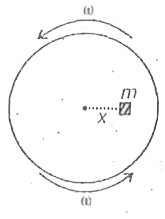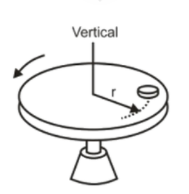A block of mass m = 20 kg is kept is a distance R = 1m from central axis of rotation of a round turn table (A table whose surface can rotate about central axis). Table starts from rest and rotates with constant angular acceleration, α=3rad/sec2. The friction coefficient between block and table is μ=0.5. At time t=x30 from starting of motion (i.e. t =0) the block is just about to slip. Find the value of x (g=10m/s2)
The correct Answer is:20
To solve the problem, we need to analyze the forces acting on the block on the rotating turntable. The block is subjected to centripetal and tangential forces due to the rotation of the table, and we need to find the time when the block is just about to slip.
Step 1: Identify the given values
- Mass of the block, m=20kg
- Distance from the central axis, R=1m
- Angular acceleration, α=3rad/s2
- Coefficient of friction, μ=0.5
- Gravitational acceleration, g=10m/s2
Step 2: Calculate the normal force
The normal force N acting on the block is equal to its weight:
N=mg=20kg×10m/s2=200N
Step 3: Calculate the maximum frictional force
The maximum static frictional force Ff can be calculated using the coefficient of friction:
Ff=μN=0.5×200N=100N
Step 4: Determine the angular velocity at time t
The angular velocity ω at time t can be calculated using the formula:
ω=αt=3trad/s
Step 5: Calculate the centripetal force
The centripetal force Fc acting on the block is given by:
Fc=mω2RR=mω2=20kg×(3t)2=20×9t2=180t2N
Step 6: Calculate the tangential force
The tangential force Ft is given by:
Ft=mαR=20kg×3rad/s2×1m=60N
Step 7: Set up the equation for slipping condition
The block will just start to slip when the maximum frictional force is equal to the resultant of the centripetal and tangential forces:
Ff=√F2c+F2t
Substituting the values:
100=√(180t2)2+(60)2
Step 8: Square both sides to eliminate the square root
10000=(180t2)2+3600
10000−3600=(180t2)2
6400=(180t2)2
Step 9: Solve for t2
Taking the square root:
80=180t2
t2=80180=818=49
Step 10: Solve for t
t=√49=23s
Step 11: Relate t to x
Given that t=x30:
23=x30
Cross-multiplying gives:
2×30=3x
60=3x
x=20
Final Answer
The value of x is 20.
---
- Mass of the block, m=20kg
- Distance from the central axis, R=1m
- Angular acceleration, α=3rad/s2
- Coefficient of friction, μ=0.5
- Gravitational acceleration, g=10m/s2
The normal force N acting on the block is equal to its weight:
N=mg=20kg×10m/s2=200N
The maximum static frictional force Ff can be calculated using the coefficient of friction:
Ff=μN=0.5×200N=100N
The angular velocity ω at time t can be calculated using the formula:
ω=αt=3trad/s
The centripetal force Fc acting on the block is given by:
Fc=mω2RR=mω2=20kg×(3t)2=20×9t2=180t2N
The tangential force Ft is given by:
Ft=mαR=20kg×3rad/s2×1m=60N
The block will just start to slip when the maximum frictional force is equal to the resultant of the centripetal and tangential forces:
Ff=√F2c+F2t
Substituting the values:
100=√(180t2)2+(60)2
10000=(180t2)2+3600
10000−3600=(180t2)2
6400=(180t2)2
Taking the square root:
80=180t2
t2=80180=818=49
t=√49=23s
Given that t=x30:
23=x30
Cross-multiplying gives:
2×30=3x
60=3x
x=20
The value of x is 20.
Topper's Solved these Questions
- DAILY PRACTICE PROBLEMBOOK - RESONANCE ENGLISHCHAPTER - DAILY PRACTICE PROBLEMEXERCISE - DPP No.40
20 Videos
- DAILY PRACTICE PROBLEMBOOK - RESONANCE ENGLISHCHAPTER - DAILY PRACTICE PROBLEMEXERCISE - DPP No.41
9 Videos
- DAILY PRACTICE PROBLEMBOOK - RESONANCE ENGLISHCHAPTER - DAILY PRACTICE PROBLEMEXERCISE - DPP No.38
20 Videos
- CURRENT ELECTRICITYBOOK - RESONANCE ENGLISHCHAPTER - CURRENT ELECTRICITYEXERCISE - High Level Problems (HIP)
19 Videos
- ELECTRO MAGNETIC WAVESBOOK - RESONANCE ENGLISHCHAPTER - ELECTRO MAGNETIC WAVESEXERCISE - Exercise 3
27 Videos
Similar Questions
A coin is kept at distance of 10 cm from the centre of a circular turn table. If μ=0.8 the frequency of rotation at which the coin just begins to slip is
View SolutionA block of mass m is kept on horizontal turn table at x distance from the centre. If coefficient of friction between block and surface of turn table is μ, then maximum angular speed of the table so that block does not slip

View SolutionA block of mass m is kept on a horizontal table. If the static friction coefficient is μ., find the frictional force acting on the block.
View SolutionA block of mass m is kept on a platform which starts from rest with constant acceleration g/2 upward, as shown in fig. Work done by normal reaction on block in time t is :

View SolutionA wheel starts rotating at 10 rad/sec and attains the angular velocity of 100 rad/sec in 15 seconds. What is the angular acceleration in rad/sec2?
View SolutionA disc of radius 5 m is rotatating with angular frequency 10 rad/sec. A block of mass 2 kg is to be put on the disc frication coefficient between disc and block isμK=0.4, then find the maximum distance from axis where the block can be placed without slidding:
View SolutionA small coin of mass 40 g is placed on the horizontal surface of a rotating disc. The disc starts from rest and is given a constant angular acceleration α=2 rad s−2. The coefficient of static friction between the coin and the disc is μs=3/4 and the coefficient of kinetic friction is μk=0.5. The coin is placed at a distance r=1m from the centre of the disc. The magnitude of the resultant force on the coin exerted by the disc just before it starts slipping on the disc is?

View SolutionA small coin of mass 80g is placed on the horizontal surface of a rotating disc. The disc starts from rest and is given a constant angular acceleration α=2rad/s2. The coefficient of static friction between the coin and the disc is μs=3/4 and cofficient of kinetic friction is μk=0.5. The coin is placed at a distance r=1m from the centre of the disc. The magnitude of the resultant force on the coin exerted by the disc just before it starts slipping on the disc is

View SolutionA small coin of mass 80g is placed on the horizontal surface of a rotating disc. The disc starts from rest and is given a constant angular acceleration α=2rad/s2. The coefficient of static friction between the coin and the disc is μs=3/4 and cofficient of kinetic friction is μk=0.5. The coin is placed at a distance r=1m from the centre of the disc. The magnitude of the resultant force on the coin exerted by the disc just before it starts slipping on the disc is

View SolutionStarting from rest, a particle rotates in a circle of radius R = √2m with an angular acceleration = π4 rad/s2.The magnitude of average velocity of the particle over the time it rotates quarter circle is:
View Solution
